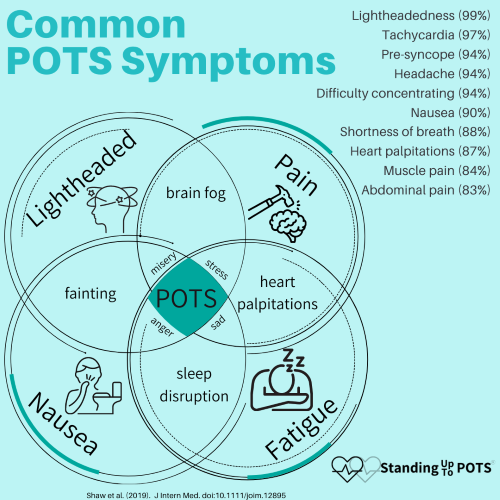Postural orthostatic tachycardia syndrome, or POTS, is a condition in which your heart starts to race when you stand up. Specifically, adults with POTS will experience a heart rate that is faster by at least 30 beats per minute in the first 10 minutes after standing.
POTS is a problem of the autonomic nervous system's control of blood flow (or circulation). Normally, when you stand up, gravity pulls more blood into your lower body; but to make sure that enough blood is still flowing to the brain, the body releases the hormones epinephrine and norepinephrine, which help tighten the blood vessels and increase your heart rate.
Causes and Risk Factors of POTS
Other health problems that are linked to POTS include impaired nerve function, poor blood circulation, and blood pressure abnormalities.
In some people, POTS may be influenced by genes. For example, variations in the genes NOS3 and ADRB2 may be linked to an increased risk of developing POTS.
Prognosis of POTS
Many people with POTS have mild symptoms, and therefore the long-term outlook is good. Medication, along with dietary and exercise changes, can help ease the symptoms of POTS — improving a patient's condition and quality of life. With time, some people may no longer experience any symptoms.
Duration of POTS
Complications of POTS
Related Conditions and Causes of POTS
POTS is one type of dysautonomia, a term that refers to multiple conditions that affect the nervous system, which regulates functions such as heart rate, blood pressure, digestion, body temperature, and more.
More than 70 million people have some type of dysautonomia, including POTS. Other forms of dysautonomia include neurocardiogenic syncope (NCS), or fainting spells. Another is inappropriate sinus tachycardia (IST), in which the heart beats unexpectedly quickly while a person is at rest or only slightly active.
According to Johns Hopkins Medicine, most adolescents and young adults with myalgic encephalomyelitis/chronic fatigue syndrome (ME/CFS) have POTS or related forms of orthostatic intolerance.
Resources We Love
Dysautonomia International
Dysautonomia International is a nonprofit organization dedicated to improving the lives of people with autonomic nervous system disorders, including POTS. They do advocacy work, spread awareness, and raise money to fund research opportunities. On their site you can also find information about POTS, both for patients and for family and friends.
Dysautonomia Information Network
This volunteer-run nonprofit provides information on dysautonomia disorders and offers a moderated online forum where you can connect with others and discuss issues related to POTS.
Genetic and Rare Diseases Information Center (GARD)
In addition to an overview of the symptoms, diagnosis, and treatment of POTS, GARD provides links to current clinical trials as well as a list of helpful organizations for people with the condition. It's run by the National Institutes of Health.
Additional reporting by Cathy Cassata.
Editorial Sources and Fact-Checking
- Postural Orthostatic Tachycardia Syndrome (POTS). Johns Hopkins Medicine.
- Postural Orthostatic Tachycardia Syndrome. Genetic and Rare Diseases Information Center. February 1, 2017.
- Raj V, Opie M, et al. Cognitive and Psychological Issues in Postural Tachycardia Syndrome. Autonomic Neuroscience. December 2018.
- Get the Facts: Sodium and the Dietary Guidelines. Centers for Disease Control and Prevention. October 2017.
- Postural Orthostatic Tachycardia Syndrome (POTS). Cedars-Sinai.
- Postural Orthostatic Tachycardia Syndrome (POTS). Cleveland Clinic. October 12, 2020.
- Postural Orthostatic Tachycardia Syndrome. Dysautonomia International.













































